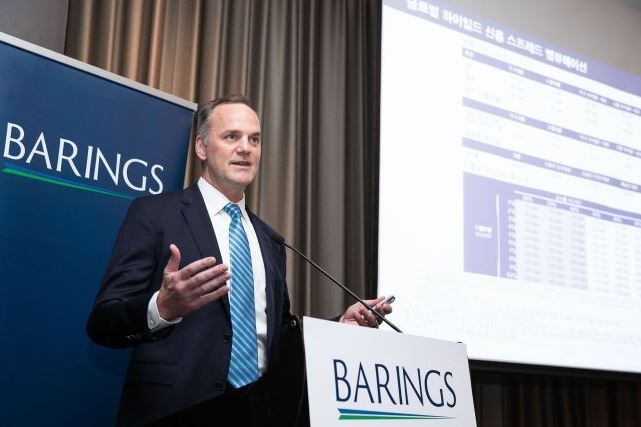A global asset management firm on Wednesday suggested diversified overseas investments in US and European high-yield bonds this year to reduce risk or volatility.
“The point of this is to say that there can be technically driven differences in the markets that cause one market to outperform or underperform another market … again this is all corporate credit,” said David Mihalick, head of Barings’ US High Yield Investments Group, during a press conference in Yeouido, Seoul.
“So generally the idea is that it’s a global opportunity set if you think about a balanced portfolio, there are opportunities to move from one geography to another to pick up more attractive spreads from what we consider the same underlying risks,” he added.

David Mihalick, head of Barings’ US High Yield Investments Group, speaks at a press conference in Yeouido, Seoul on Wednesday. (Barings)
Mihalick pointed out that during the 2011 European debt crisis, the US high-yield bonds recorded a 4.91 percent return-call, while Europe saw a 1.36 percent loss. During the 2015 US commodity crisis, the US saw a 5.38 percent loss and Europe gained 1.46 percent.
“If you think about 2011, of that timeframe coming out of the great financial crisis and (2010 to 2012), we had issues of peripheral European countries that caused a significant sell-off in the European market,” Mihalick said.
“Our strategy was we looked at those markets and thought underlying corporate fundamentals were attractive and the companies would generally be okay.”
Mihalick added that for this year, the European market paints a promising outlook when compared to the US market, with European banks recently sizing down on corporate loans, and the overall demand of loans shifting to demand of bonds.
Diversified investment in US and European high-yield bonds would result in a good return this year, he said, as high-yield “is a fixed rate product (that) actually tends to do good in either flat or rising rate environment.”
By Jung Min-kyung (
mkjung@heraldcorp.com)






